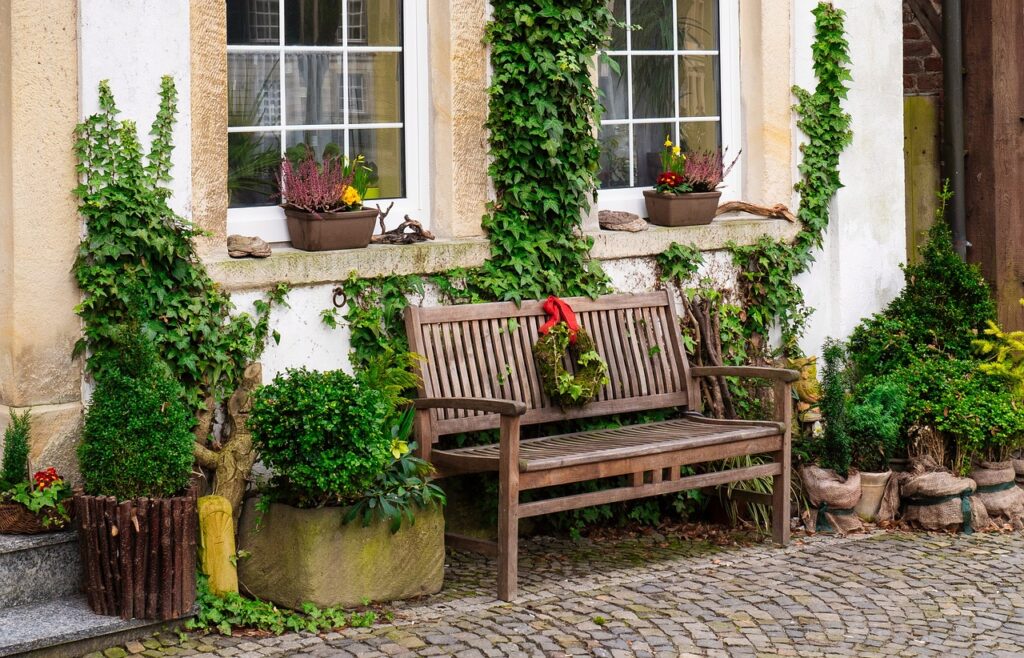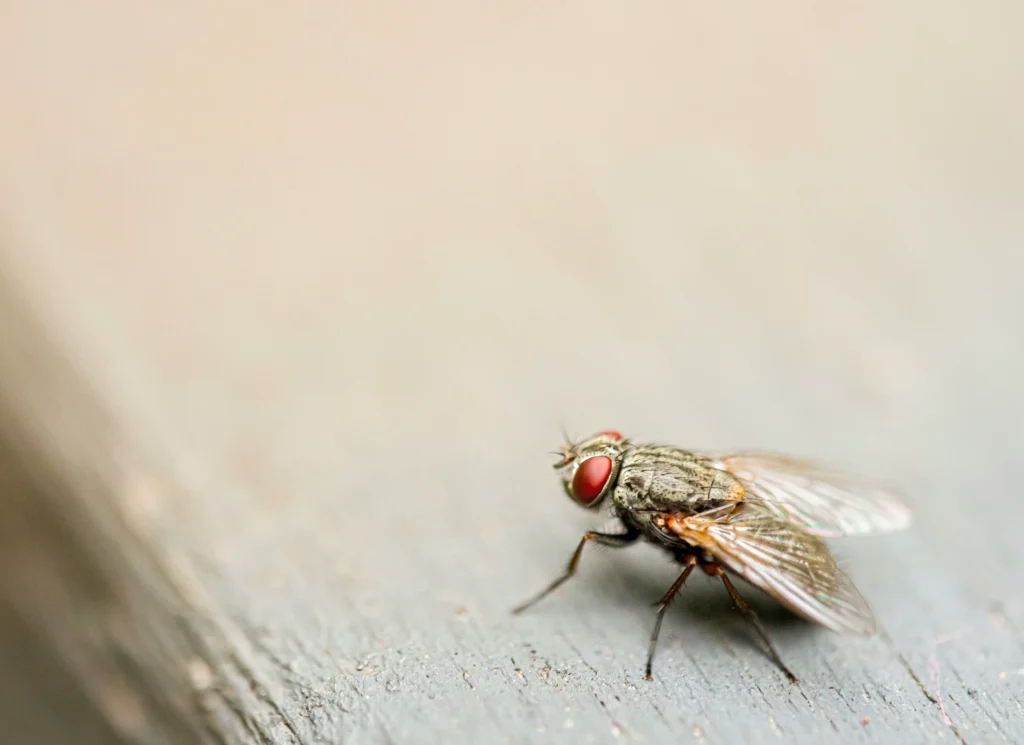Contents
- 1 Intro
- 2 Contents
- 3 Gardening Tools: The Essentials Explained
- 3.1 Gardening Gloves – Protecting Your Hands
- 3.2 Hand Trowel – The Gardener’s Best Friend
- 3.3 Pruning Shears – Keeping Your Garden in Shape
- 3.4 Garden Fork – Breaking New Ground
- 3.5 Spade – The Essential Digging Tool
- 3.6 Rake – The Groundskeeper’s Go-To
- 3.7 Hoe – The Weed Warrior
- 3.8 Watering Can – The Life Giver
- 3.9 Wheelbarrow – The Heavy Lifter
- 3.10 Garden Hose with Adjustable Nozzle – The Watering Workhorse
Intro
Gardening tools names always make up for great confusion. After all, tending to a garden is a fulfilling pastime that requires more than just a green thumb. Ask any seasoned gardener, and they’ll agree that no planting process can be fulfilled adequately without specialized tools. Today, we’re on a gardening journey to explore the essential gardening tools that every gardener, from the novice to the expert, should have in their repertoire. Whether they are pruning tools, digging tools, weeding tools, or whether you simply want to accomplish your gardening tasks more efficiently, we cover the essential tools you need.
Contents
Gardening Tools: The Essentials Explained
Gardening Gloves – Protecting Your Hands
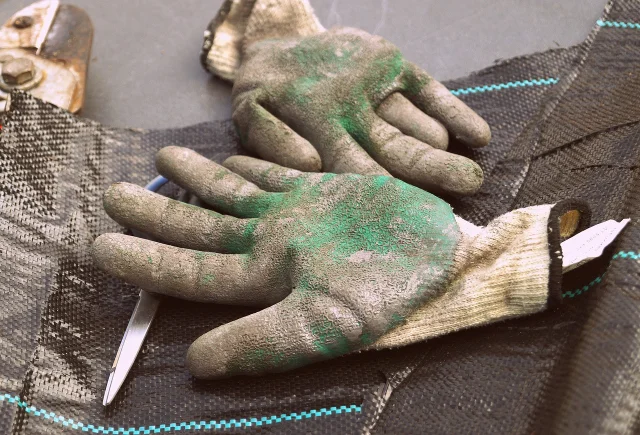
Ensuring the protection and comfort of your hands should be at the top of your priority list when working on almost any gardening task. Gardening gloves shield your hands from dirt, thorns, and potential irritants. They come in various materials, ranging from leather to rubber or neoprene, and offer different levels of durability, dexterity, and water resistance. Form-fitting styles enhance grip, whereas longer cuffs protect the wrists and forearms from scratches and insect bites.
In choosing the right pair, consider the specific tasks you’ll be undertaking and the season. Heavy-duty gloves are best for working on thick branches or for breaking ground with heavier tools, while lighter, breathable gloves may suffice for watering plants, getting a loosen soil, removing weeds, indoor planting and potting.
Types, Styles, and Applications
Leather Gloves
These are the workhorses of the glove world, providing a balance of toughness and suppleness. Leather gloves are perfect for heavy-duty jobs like landscaping and pruning, offering excellent protection against thorns and sharp objects.
Rubber Gloves
Also known as nitrile gloves or coated gloves, these are the go-to for wet conditions. They provide a firm grip and keep your hands dry and less susceptible to chemical abrasion.
Cotton Gloves
When it comes to comfort and breathability, cotton gloves are a gardener’s best friend. They’re great for light maintenance, weeding, and planting in dry conditions.
Finding the right pair often involves trying out different styles to see what compliments your gardening routine. Remember to replace gloves when they become worn or you notice any damage, as a weakened glove can easily tear under pressure.
Hand Trowel – The Gardener’s Best Friend
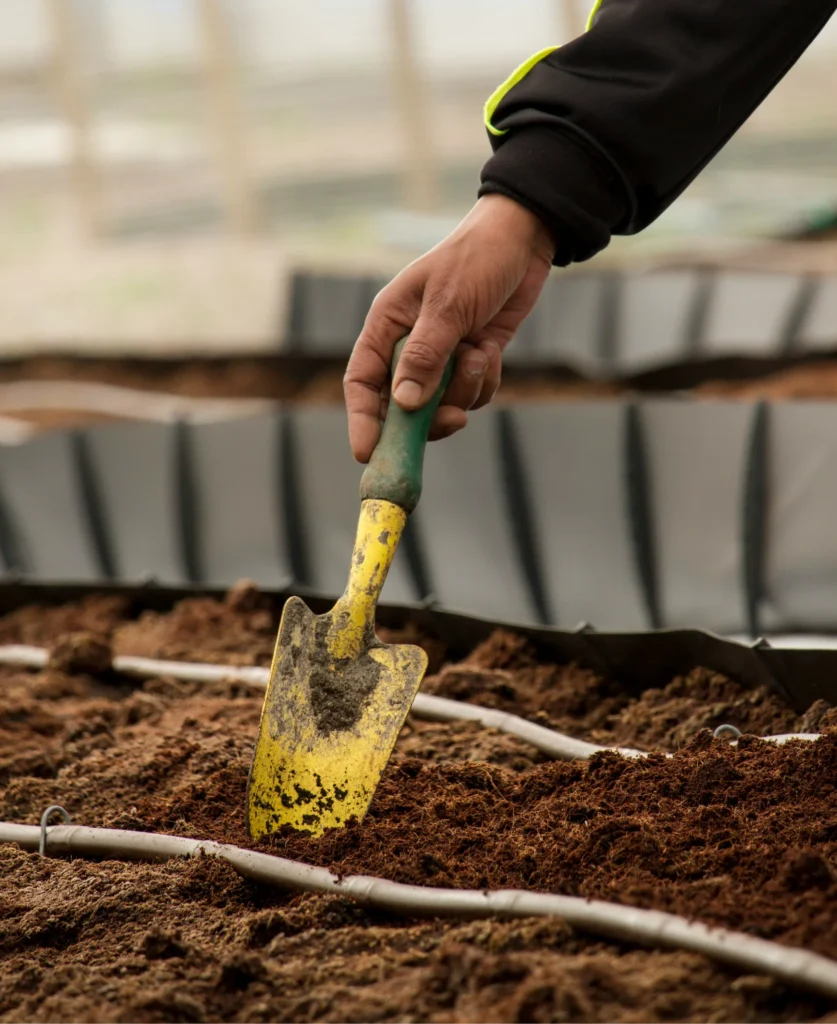
The hand trowel, also known as a garden trowel, is the lynchpin of a gardener’s kit and a must-have gardening tool. It’s a small tool with a pointed, scoop-shaped metal blade and a handle, typically wooden or plastic. A hand trowel serves a multitude of purposes, ranging from planting bulbs and flowers to removing unwanted weeds or digging small holes. The sturdy design efficiently transfers soil and compost where it’s needed without causing unnecessary disruption. Its compact size allows you to work efficiently even in tight spots, making it a widely loved and versatile gardening tool.
Types, Styles, and Applications
Planting and Transplanting
When working with small plants or developing your garden bed, use the trowel to make holes of the right depth and size. Its narrow profile ensures that the root ball can be placed securely without unnecessary soil disturbance.
Weeding
A trowel is great for tackling weeds in awkward spaces or near delicate plants. Its sharp edge allows you to get under the root, providing for effective removal without disturbing the surrounding soil.
Digging Up Bulbs
Use the trowel to carefully dig up bulbs in preparation for dividing or storing for the season.
A good trowel will have a sturdy, rust-resistant blade that tapers to a point for maximum precision. Some also have measurement markings to help with planting depth.
Pruning Shears – Keeping Your Garden in Shape
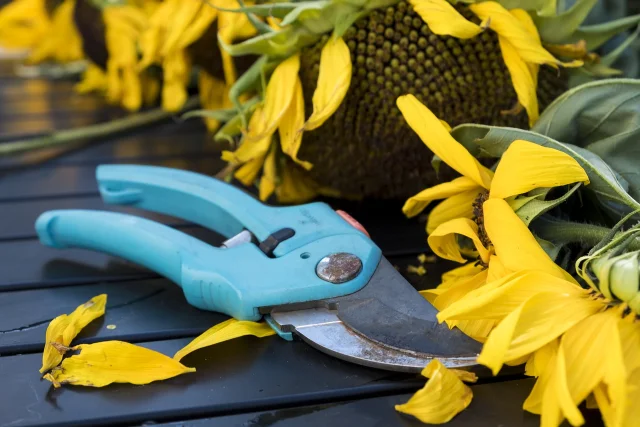
For garden maintenance and plant health, pruning shears (or secateurs) are essential. These scissors-like tools come with a spring that reopens the blades after each cut, reducing hand strain. Pruning shears come in two types: anvil and bypass. Anvil pruners have a sharp blade that closes against a flat edge and are perfect for deadwood and tough tree branches. Bypass pruners have a scissor-like action, with two curved blades that pass by each other, ideal for live branches and stems. Work on bigger plants may require the use of a pruning knife or pruning saw, but most gardeners do well with a simple pruning shear.
Regularly maintaining and shaping plants with your pruning shears promotes airflow, prevents diseases, and encourages healthy growth. Check the video below for some interesting tips on pruning your trees.
Types, Styles, and Applications
Deadheading and Crown Cleaning
Regularly remove spent flowers to encourage the flowering of new buds. Remove diseased and dead wood to help prevent the spread of diseases.
Shaping
Use pruning shears to control the size and shape of plants. Trim unruly branches and stems that are growing out of bounds.
Thinning
Cultivate optimal air and light penetration by pruning overcrowded branches, which can lead to a healthier, more productive garden.
Keep your shears well-maintained by sharpening the blade, adjusting the tension, and occasionally oiling the moving parts. A well-cared-for pruner is easier to use and reduces the risk of accidental injuries.
Garden Fork – Breaking New Ground
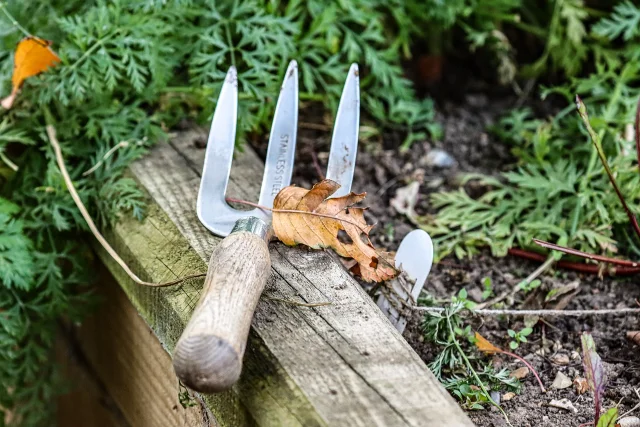
Garden forks are the heavy lifters of your tool inventory, designed for tasks that require a robust tool. These tools have a sturdy handle capped with three or more thick, strong tines. The most common garden fork is the digging fork, useful for breaking and aerating compacted soil, turning compost, and lifting root crops like potatoes. A garden fork is not meant for digging straight down as a garden spade would; its prongs can spread the earth and help you avoid damaging tender root systems, making it an essential tool for permaculture practitioners and sustainable gardeners.
Types, Styles and Applications
Aerating Soil
One of the most important roles of the garden fork is to aim for no compacted soils and allow air to reach the roots, so plant growth and health can be greatly improved. Used in a similar action to a garden spade, but without removing much soil, the fork is driven into the ground and then wiggled back and forth to create air channels.
Harvesting Root Vegetables
The space between the fork’s prongs allows for easy lifting of potatoes, carrots, and the like, without damaging the crop.
Turning Compost
Utilize the garden fork to mix and aerate your compost heap, ensuring a more even breakdown and preventing odors.
Choose a garden fork with sturdy steel tines and a comfortable handle. Tines that come out too far apart risk bending, so a well-designed fork will have tines set close together for maximum strength.
Spade – The Essential Digging Tool
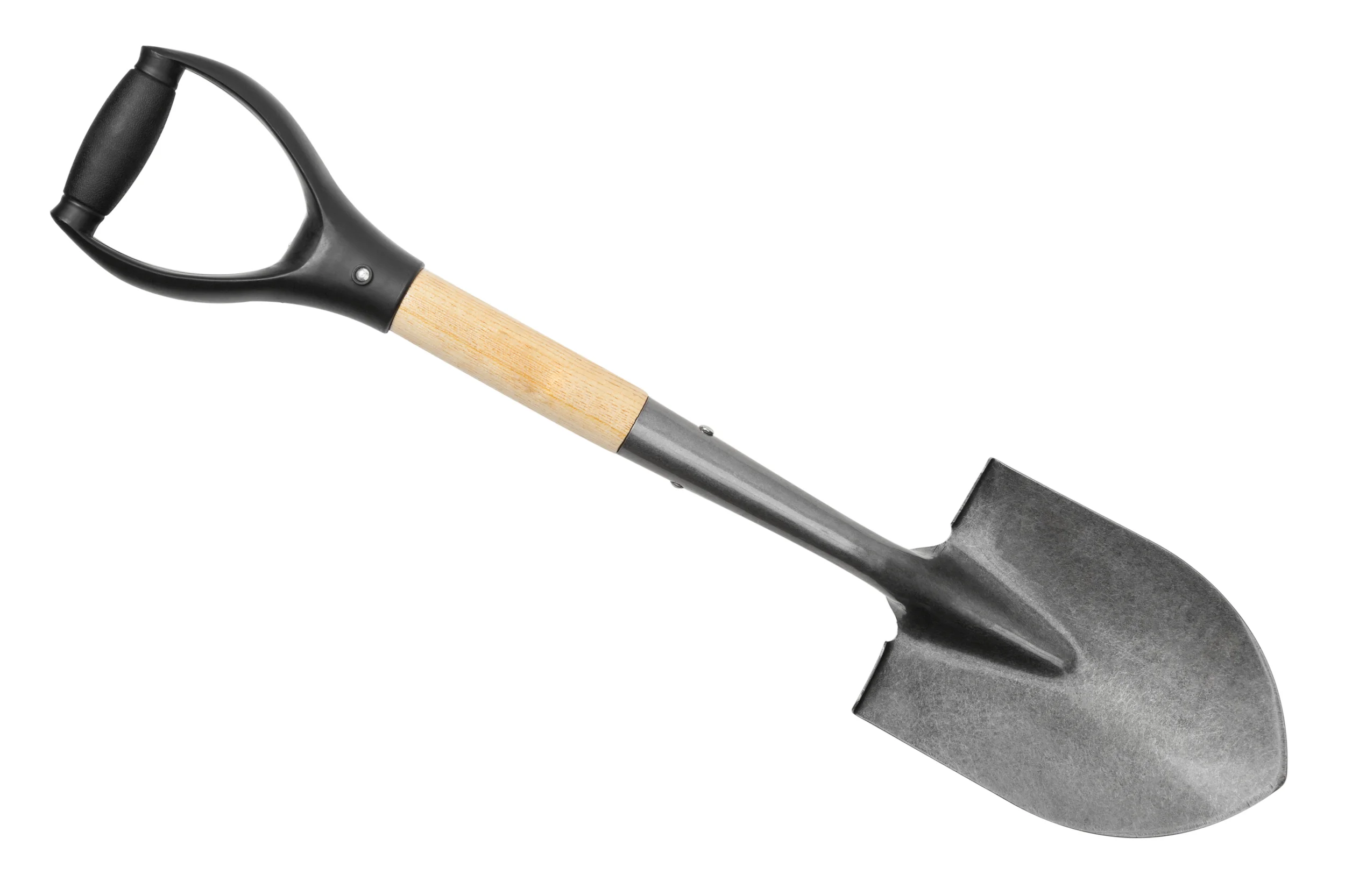
When precision and robustness are required, the garden spade steps in. Its flat, squared-off metal blade with a straight or shaped edge provides a sharp and solid cutting surface, perfect for digging straight-sided holes, shaping beds and borders, and edging. There are different varieties of spades, with each serving a unique purpose. A border spade, for example, has a slightly smaller head and is perfect for working in smaller spaces, while the heavier digging spade is designed to tackle dense soils and other challenging tasks.
Types, Styles, and Applications
Digging Planting Holes
When you want a hole with straight, even sides, as many planting instructions recommend, the spade is the go-to digging tool. It’s also ideal for making trenches for irrigation systems or for laying paths in your garden.
Edging Beds
For cutting crisp edges along pathways or flower beds, a spade is essential. Push the blade straight down to the depth you require, and then lever soil out to create a well-defined boundary.
Lifting Sod
When transplanting grass or creating a new lawn, a spade allows you to lift cut sod conveniently and with minimal risk of damage.
High-quality spades have a comfortable, contoured D-grip handle and a strong, sharp blade. The blade’s design will often indicate the spade’s intended purpose – concave blades are good for digging straight-sided holes, while flat edges are ideal for cutting an edge.
Rake – The Groundskeeper’s Go-To
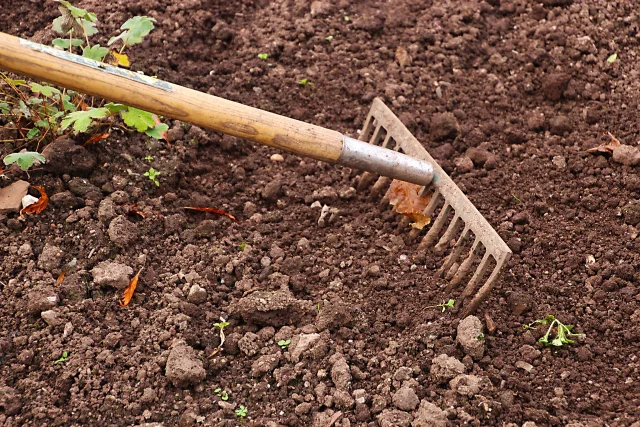
Rakes are among the most versatile of gardening tools, with variants designed for different gardening needs. The most recognizable type of rake is the leaf rake, which, with its wide tines, is perfect for gathering leaves, grass clippings, and other lightweight, loose materials. Thatch rakes have closer, sharper tines and are used to remove dead grass and other debris that can suffocate a lawn. Leveling rakes, or bow rakes, are equipped with a straight edge in addition to tines, making them suitable for leveling, spreading material, and working soil. A high-quality rake is a durable and multi-functional tool, perfect for maintaining the tidiness of your garden beds and lawns.
Types, Styles, and Applications
Leveling and Spreading
When constructing beds or lawns, a rake with a straight edge can be used to level and spread topsoil, compost, or other materials.
Thatch Removal in Lawns
The specific shape and tine design of a thatch rake will help you remove the thick layer of dead grass and root material that can prevent your lawn from growing healthily.
Fall Maintenance
Use a wide, curved rake when working with large piles of leaves or lawn clippings – its design helps you gather more material at once. And before you think about a leaf blower, think sustainability!
Rake heads come in various sizes, with flexible or rigid tines, depending on the task at hand. Adjustable rakes allow you to change the width of the head for more or less coverage, giving you flexibility in both small and large projects.
Hoe – The Weed Warrior
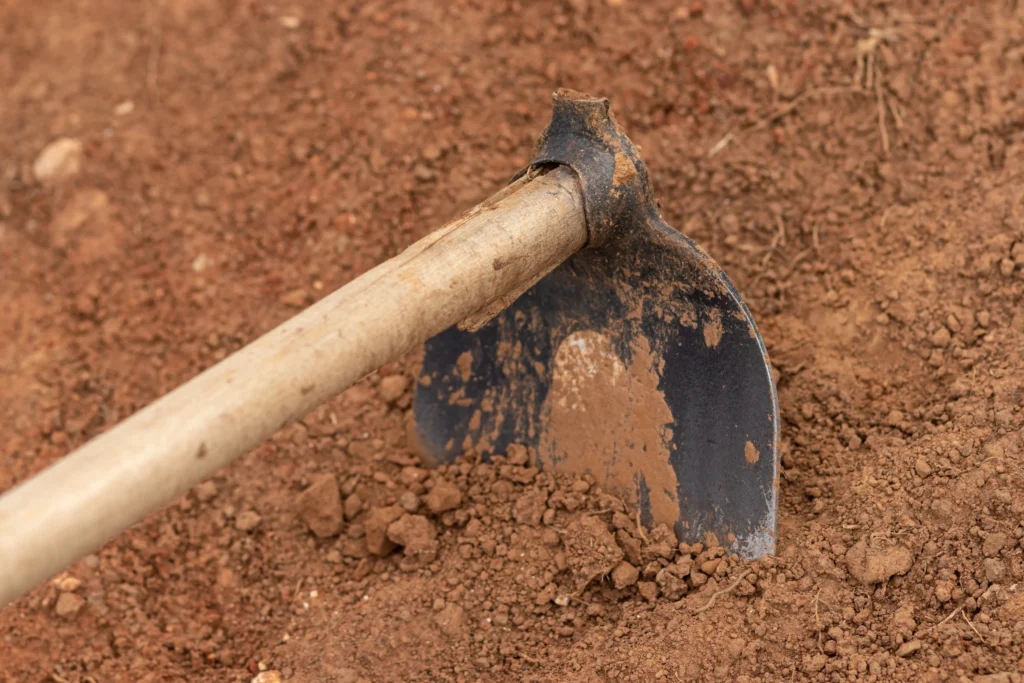
For weeding and cultivating the soil, garden hoes are a gardener’s best friends. It’s characterized by a long handle with a slightly angled flat metal blade. A sharp, sturdy hoe face is perfect for cutting into the earth, chopping up roots, and creating furrows for planting. The action of using a hoe is a push-pull motion that’s easier on the back than bending over with a trowel or hand weeder. There are several different hoes for different tasks – the Dutch hoe, for example, is ideal for weeding and breaking up the topsoil, while the scuffle or winged hoe allows you to slice beneath the soil to cut weeds at the roots.
Types, Styles, and Applications
Stirrup Hoe
With a blade that is shaped like a stirrup, this hoe is ideal for breaking up soil and weeding. Its sharp edge cuts through roots and soil with minimal effort, making it very efficient.
3-Prong Cultivator
This hoe has three prongs that allow you to pull it towards you or push it away for more control when working the soil or weeding.
Triangle Hoe
With a triangular blade, this type of hoe is suitable for making furrows for planting and for breaking up clods of soil.
When using a hoe, keep the handle at an angle that allows you to push and pull without exerting too much force. The hoe is designed to work with the resistance of the soil, not against it.
Watering Can – The Life Giver
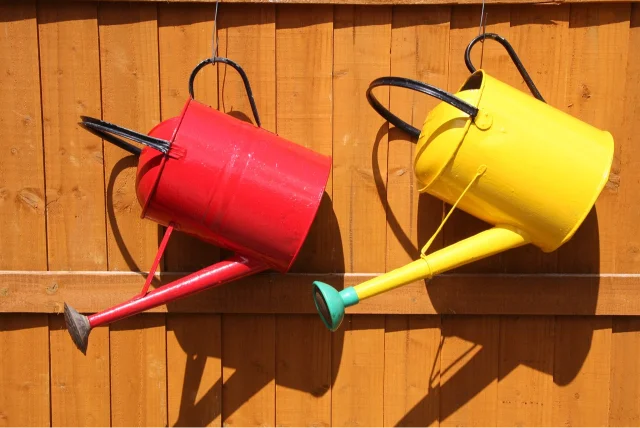
When it comes to watering tools, a watering can is a must-have. Whether you’re caring for indoor plants, newly seeded areas, or delicate blooms, the gentle flow from a watering can prevents soil erosion and over-watering, i.e., it helps the provision of adequate soil moisture. Modern watering cans come with a long spout and a rose (the attachment that diffuses water into a soft, gentle stream), and are often designed with balanced handles to reduce the strain on the wrist. Look for cans made from galvanized metal or plastic for durability and ease of use.
The watering can is not just a tool but a lifesaver, especially in periods of drought or when the use of a hose is impractical.
Types, Styles, and Applications
Seedling Care and balanced irrigation
A watering can with a fine rose is essential for the gentle watering that young plants require. Use a watering can with a spout that allows you to direct water where it’s needed without too much splashback.
Foliar Fertilization
Mix liquid fertilizers and nutrients into your watering can to apply directly to the leaves of your plants.
Balance the weight of the can with the amount of water you need to carry; you don’t want to overexert yourself. Some modern cans include a longer spout for easier watering in hard-to-reach areas. For heavy watering tasks, a can made from a lightweight but durable material like resin is your best bet.
Wheelbarrow – The Heavy Lifter
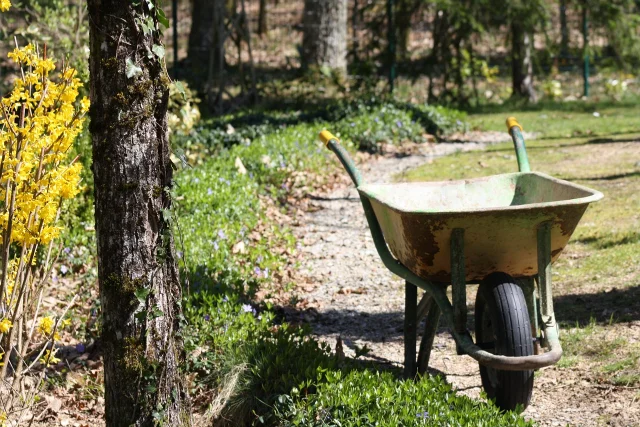
Transporting soil, mulch, rocks, or garden tools becomes a breeze with the help of a wheelbarrow. It’s a simple but invaluable tool for any gardener, with a single wheel or a pair supporting a deep basin, allowing for easy carrying and dumping. Some wheelbarrows come with two handles, while others feature a single bar that doubles as a stand to stabilize the wheelbarrow. Consider the terrain where you’ll be using the wheelbarrow – pneumatic tires are best for uneven ground, while solid rubber tires require less maintenance and are less prone to punctures.
Whether you’re transporting potting soil or carrying away debris, a wheelbarrow is an efficient way to move items within the garden.
Types, Styles, and Applications
Planting and Mulching
A wheelbarrow allows you to carry large loads of soil, compost, and mulch for quicker and more efficient planting and mulching.
Yard Clean-Up
A wheelbarrow is essential for moving heavy bags of leaves or grass to the compost pile or waste bin.
Transporting Tools
When you’re working in a large garden, a wheelbarrow can save you a lot of time by lugging around your other tools and materials.
Choosing the right wheelbarrow depends on the stability of the frame, the weight capacity of the bin, and the type of material (plastic or metal) you prefer. Look for models with pneumatic tires for smoother rolling, especially on uneven terrain.
Garden Hose with Adjustable Nozzle – The Watering Workhorse

For watering large areas and cleaning garden equipment, a garden hose with an adjustable nozzle reigns supreme. The hose is your connection to one of the main elements in the garden – water – and the nozzle fine-tunes the flow to suit the task at hand. A shower setting mimics light rainfall for delicate moisturing, while a jet setting provides a powerful stream for cleaning hard surfaces or reaching tall plants. Garden hoses range in length and material, with vinyl and rubber being the most common due to their flexibility and resistance to kinking. When purchasing a garden hose, consider storage options and whether you need additional connectors for your watering needs.
The hose is the lifeline of your garden when it comes to watering. A versatile nozzle can accommodate the different watering needs of your plants, and the right hose will make your job easier and more efficient.
Types, Styles, and Applications
Adjustable Water Flow
A good hose will allow you to change the water pressure from a gentle sprinkle to a powerful jet, suitable for a variety of tasks.
Kink Resistance
Opt for a hose that has been tested for kink resistance, so you’re not dealing with frustrating interruptions to your water flow.
Length and Diameter
Consider the size of your garden and the reach you’ll need – a compromise must be struck between convenient length and manageable weight and width.
Investing in a quality garden hose with a durable nozzle can significantly cut down your watering time and build a robust irrigation system for your garden that will last for years.
We are part of Amazon Associates Program (affiliate) and may earn a commission if you purchase from the link above.

